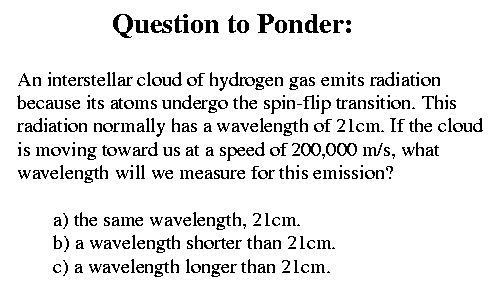|
|
Movin' through the sheres, faster than light On our way to some planets that were outta sight We said space driver, give it a spin And take us to some places we ain't never been B-52's, Is that You Mo-Dean |
Assignments:Read Chapter 32, Sections 5 and 6 (pp. 530-533)
Problem Set #5
Check out these images of radio telescopes:
|

In Class:
-----------------------------------
review:
seeing spectral line emission from cold hydrogen
- most of the ISM too cold for hydrogen to be excited to
its first excited electronic state
- all of it is in the ground state
- BUT, the ground state is actually two energy states
very close together
- Energy depends on the orientation of the spins of the
electron and proton
- difference in energy is tiny compared to difference in
electronic energy states
- when an atom switchs states through a "spin-flip"
transition, it liberates a tiny photon
frequency = 1,420,600 Hz
wavelength = 21 cm
-- long wavelength radio photons
-- can be detected with radio telescopes
Because of this emission, we can map the distribution of Hydrogen
in our galaxy (and in others, too)
- since H is by far the most abundance element in the
universe, mapping all of the H between the stars
basically means mapping all of the stuff there is
between the stars
------------------------------------
- most of the mass in the ISM is located in the galactic disk
- flat as a pizza (actually considerably flatter)
- this stuff hangs out with most of the stars in our galaxy
------------
OK, so what about Kant's assertion that our galactic disk must be rotating?
- recall that Kant figured it must be so, or the gax would
just collapse under its own gravity
- how can we test it?
- we now have spectral line emission from the gas in the disk
- if the disk is rotating shouldn't we be able to see it?
- Let's look
- If the Gax is rotating
- part is coming toward us
emission from those gas clouds should be at slightly
higher frequency due to Doppler
- part going away from us
emission from those gas clouds should be at slightly
lower frequency due to Doppler
- should be a "switch" at the center of the galaxy
- one side coming toward ("blueshifted")
- other side going away ("redshifted")
- what does the HI emission look like?
- galactic rotation and rotation curves
- x-axis is direction along the galactic plane
- y-axis is velocity determined from the doppler shift
- can actually "see" the rotation Kant predicted
- stuff on the inside moves faster
- stuff on the outside moves more slowly
- a little tricky because we're moving around the galaxy, too
--> From HI observations, we see the gax rotating
Kant was right
why is it possible to see the rotation?
1) spectral line emission from cold gas
- doppler effects give velocity
2) radio wavelengths (so you see the whole gax)
not only can we get the qualitative result that the gax is rotating
but we can also be quantitative
- how fast is it rotating
- is the inside moving faster than the outside?
we can calculate a "rotation curve" for the galaxy
orbital speed of stuff vs. distance from the center of the gax.
- this can actually tell us a lot about where the mass is in the gax
- we can assume that the speed of stuff is just enough to
offset the pull of gravity
- if all of the mass were at the center, then objects
far away wouldn't have to move as fast as nearby
objects to offset the pull of gravity
- far away objects are distant, so the pull of gravity is
weaker out there
--> would expect decrease in velocity with distance
recall that we can calculate the mass of an object
by measuring how fast something orbiting it moves
M = v^2 R/G
For the solar system all of the mass is at the center
so,
v = sqrt(GM/R) <-- speed decreases as the squre root of the
distance from the center
- for the Galaxy, that's not what we get. Why?
- not all of the gax's mass is at the center
- we knew that already
- the gax is a big disk of material
- this relation tells you how much mass is INSIDE
the orbit of the object
- doesn't say anything about what's outside
- so objects close to the center fell a pull from only part
of the gax's mass -- the part inside their orbit
- objects further out are farther away, but they feel the pull
from a larger fraction of the gax's mass
-- therefore, they have to move more quickly than they
would if they only felt the gravity from the mass
inside the inner object's orbit
--> result: a "flat" rotation curve
-- means a lot of the mass of the gax is distributed
away from the center
|
![]()